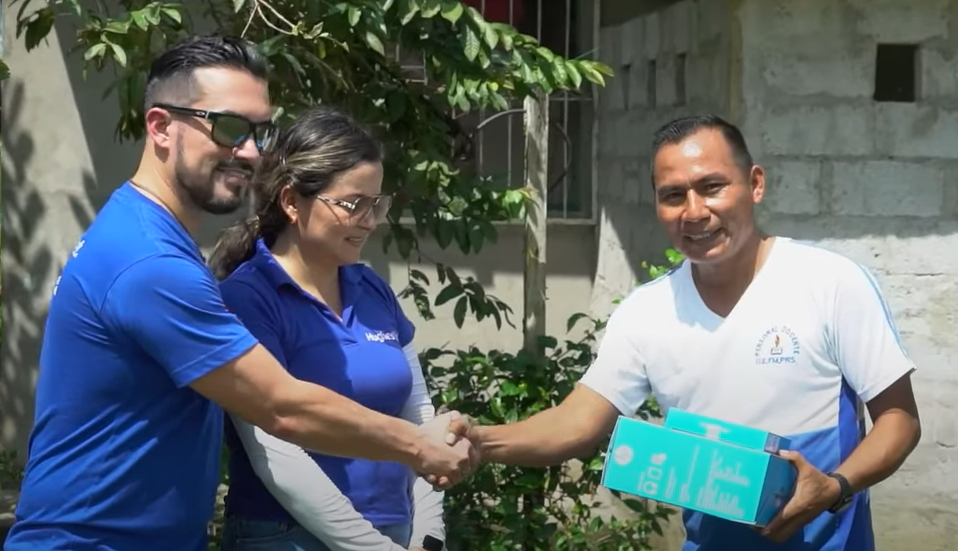Latest News

Francisco Licuy in Puerto Salazar, Ecuador. Screenshot via “Path to the Good Life” via SSPI/YouTube
A few short years ago, the question posed by that title would have been laughable. How could the future of the internet – with its 997 terabits per second of global capacity at the end of 2022 – depend on something as costly and bandwidth-constrained as satellite?
But the idea is not as strange as it sounds – and it’s worth thinking about, because it highlights the unique contributions our business can make to the world’s network of networks.
The horrid war-of-choice that Russia launched in Ukraine a year ago delivered yet another lesson on the fragility of terrestrial telecom. Whenever disaster strikes, whether natural or human-made, it takes out vital infrastructure, with wireless towers and communication cables at the top of the list. But in February, Ukraine’s Minister of Digital Transformation asked Elon Musk on Twitter to provide Starlink service as a replacement. Musk instantly agreed. Starlink service was activated in Ukraine and the first shipment of terminals reached the country on February 28. By the end of 2022, the company had delivered free service and donated more than 20,000 terminals at an estimated cost of $100 million. In November, Ukraine began asking allies to help fund further service and terminals.
What satellite brings to the internet is resilience. When towers fall, server rooms are flooded or island nations are taken offline by a submarine cable cut, satellite still delivers. The more satellite is integrated into connectivity, the more resilient the internet becomes. With thousands of more satellites headed for Low- and Medium-Earth Orbit orbit in the next few years, the resilience is growing fast. And with climate change making itself felt in the lives of billions of people, the value of that resilience will keep rising year by year.
The Internet That’s Everywhere
If you have ever ridden America’s Amtrak line between Boston and Washington, you have experienced the promise and the pain of mobile internet. Sure, there is a Wi-Fi connection in every car, but the internet itself appears, vanishes and appears again. Your Teams call jitters before dropping out. Your Slack session or email client is overwhelmed by the spinning wheel of death. That’s what happens when dozens of people are using a cellular circuit in a train car rolling fast (by American standards) through cell sites. It is why any organization with a serious need for internet connectivity on the move or in remote places spends money on satellite.
Contrast the Amtrak ride with the new Carnival Celebration cruise ship. When it left port for its maiden voyage in November 2022, it had access to 1.3 Gb of bandwidth for the full itinerary of the voyage, with the ability to burst to 1.8 Gb on demand. Two Orbit Ka-band antennas and a managed service from Speedcast made it possible. Delivering that level of service took more than satellite bandwidth – it required network management technology for beam-switching and the blending of multiple connectivity paths into a single, optimized WAN. The same technology is making it possible for high-value applications to combine LEO with MEO and GEO to deliver the committed information rate that customers demand.
Business model innovation is also at work. Hughes offers a Community Wi-Fi service that shares a single high-bandwidth satellite link among multiple sites in remote villages and school campuses. One of its most important contributions is to raise the quality of education in places that were once too poor and remote to afford technology.
You have probably read about the threat posed by quantum computing to the encryption we depend on for commerce and privacy on the internet. This evolving technology is expected to be uniquely suited to breaking today’s encryption – but data scientists are hard at work producing encryption system that use a “quantum key” to secure communications. Making that work, however, requires an absolutely secure way to distribute quantum keys. For reasons far above my pay grade, satellite-based distribution has unique potential to do so on a global scale, which is why ESA, among others, has a project to prove the technology.
So, whether its resilience, ubiquity or security, satellite seems to be on course to play a crucial role in the future of the internet. Not since Sir Arthur C. Clarke envisioned three space stations in GEO blanketing the globe with connectivity has anyone dared to make a claim like that.
 Robert Bell is executive director of Space & Satellite Professionals International. SSPI produces the Better Satellite World campaign, which dramatizes the immense contributions of space and satellite to life on Earth. More at www.bettersateliteworld.com.
Robert Bell is executive director of Space & Satellite Professionals International. SSPI produces the Better Satellite World campaign, which dramatizes the immense contributions of space and satellite to life on Earth. More at www.bettersateliteworld.com.
Get the latest Via Satellite news!
Subscribe Now